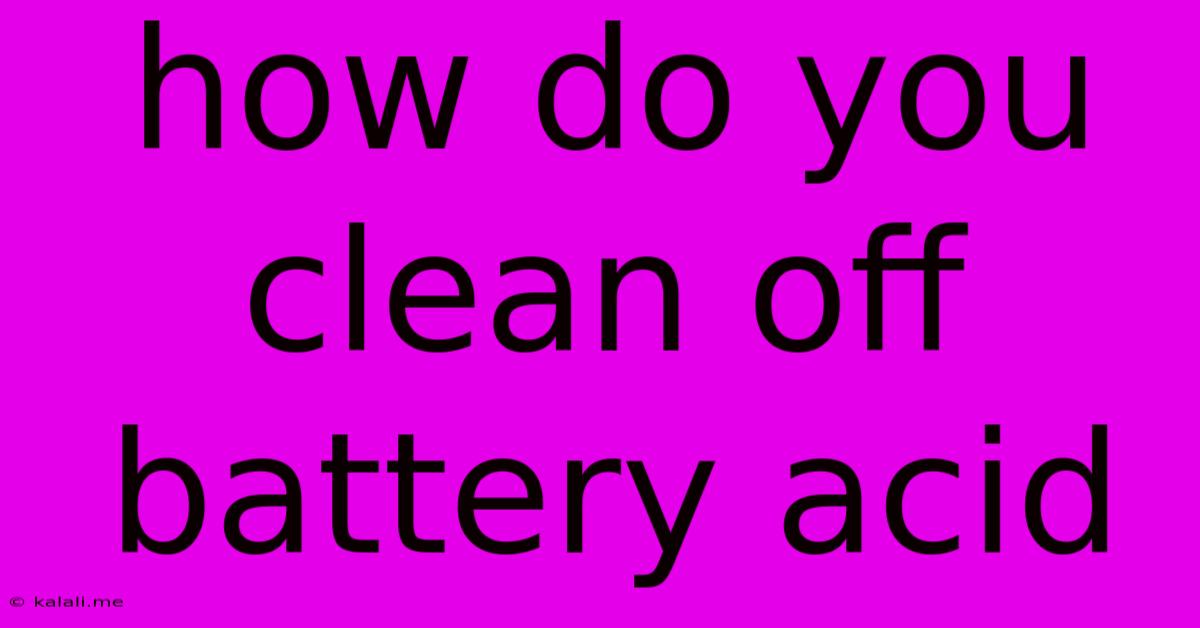How Do You Clean Off Battery Acid
Kalali
Jun 03, 2025 · 3 min read

Table of Contents
How to Clean Up Battery Acid Safely and Effectively
Battery acid, also known as sulfuric acid, is a highly corrosive substance that requires careful handling and cleanup. Accidental spills can cause damage to surfaces, equipment, and even skin. This guide provides a comprehensive approach to safely cleaning up battery acid spills, prioritizing your safety and environmental responsibility. Knowing how to properly neutralize and clean battery acid is crucial for preventing injury and damage.
Understanding the Dangers of Battery Acid
Before tackling the cleanup, it's vital to understand the risks. Sulfuric acid is a strong acid that can:
- Cause severe burns: Contact with skin or eyes can lead to severe chemical burns requiring immediate medical attention.
- Damage materials: It corrodes many materials, including metals, plastics, and fabrics.
- Produce harmful fumes: The reaction with certain substances can create toxic and irritating fumes.
- Pollute the environment: Improper disposal can contaminate soil and water sources.
Essential Safety Precautions
Always prioritize safety when handling battery acid or cleaning up a spill. Never attempt cleanup without the proper protective gear. This includes:
- Eye protection: Safety goggles or a face shield are mandatory.
- Hand protection: Wear heavy-duty rubber gloves resistant to acids.
- Protective clothing: A long-sleeved shirt, long pants, and closed-toe shoes are recommended.
- Respiratory protection: A respirator or dust mask might be necessary, especially in poorly ventilated areas.
Steps for Cleaning Up Battery Acid Spills
The cleanup process depends on the size and location of the spill. Here's a step-by-step guide:
-
Contain the Spill: First and foremost, prevent further spread. Use absorbent materials like kitty litter, sand, or diatomaceous earth to absorb the liquid. Avoid using materials that will react with the acid, like cloths or paper towels.
-
Neutralize the Acid: This is crucial to reduce the corrosive properties. A common neutralizing agent is baking soda (sodium bicarbonate). Gently and slowly add baking soda to the absorbed acid. The reaction will produce fizzing (carbon dioxide gas), which is normal. Continue adding baking soda until the fizzing stops, indicating neutralization.
-
Clean the Area: Once neutralized, carefully scoop up the absorbent material and place it into a sealed container. Use a damp cloth and water to clean the affected surface thoroughly. Always rinse the affected area generously with water after cleaning.
-
Dispose of Waste Properly: The neutralized waste should be disposed of according to local regulations. Contact your local waste management authority for guidance on proper disposal procedures. Never pour battery acid down the drain or into the trash.
-
If a spill gets on skin or in eyes: Immediately flush the affected area with copious amounts of water for at least 15 minutes. Seek immediate medical attention.
Cleaning Specific Surfaces
The cleaning process might need adjustment based on the affected surface:
- Concrete: After neutralization and cleaning, use a concrete cleaner to remove any stains.
- Metal: Neutralization is crucial, followed by thorough rinsing and possibly the use of a metal polish.
- Clothing: Immediately remove any contaminated clothing and dispose of it safely. The clothing may be irreparably damaged.
Preventing Future Spills
Prevention is always better than cure. Here are some tips to prevent future battery acid spills:
- Handle batteries carefully: Avoid dropping or jarring batteries.
- Store batteries properly: Keep batteries in a cool, dry, and well-ventilated area, away from children and pets.
- Regular inspection: Regularly inspect battery terminals for corrosion and leaks.
- Proper disposal: Dispose of old batteries appropriately at designated recycling centers.
Cleaning up battery acid requires careful attention to safety and proper procedures. By following these steps, you can effectively and safely neutralize the acid and minimize the risk of injury and damage. Remember, if you are unsure about any aspect of the cleanup, it's always best to consult a professional.
Latest Posts
Latest Posts
-
When Does Naruto Discover His Chakra Nature
Jun 05, 2025
-
Can You Paint Over Latex Paint With Oil Based Paint
Jun 05, 2025
-
My Heater Blows Cold Air Car
Jun 05, 2025
-
Diatomaceous Earth Is It Safe For Dogs
Jun 05, 2025
-
Which Of These Statements Is Correct
Jun 05, 2025
Related Post
Thank you for visiting our website which covers about How Do You Clean Off Battery Acid . We hope the information provided has been useful to you. Feel free to contact us if you have any questions or need further assistance. See you next time and don't miss to bookmark.